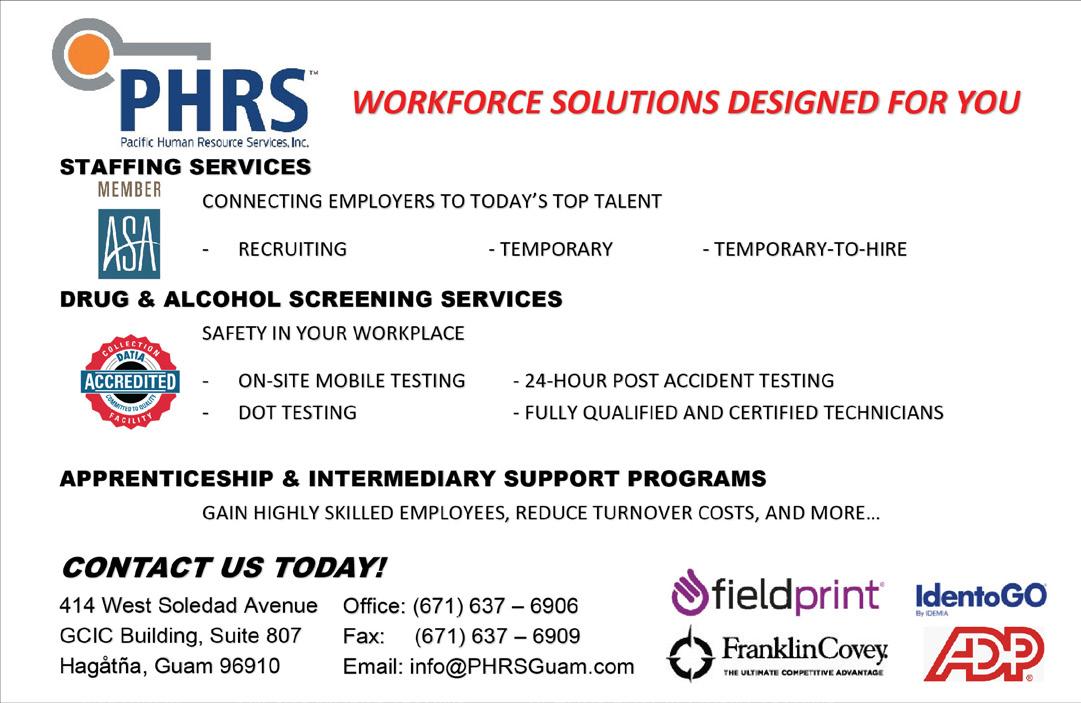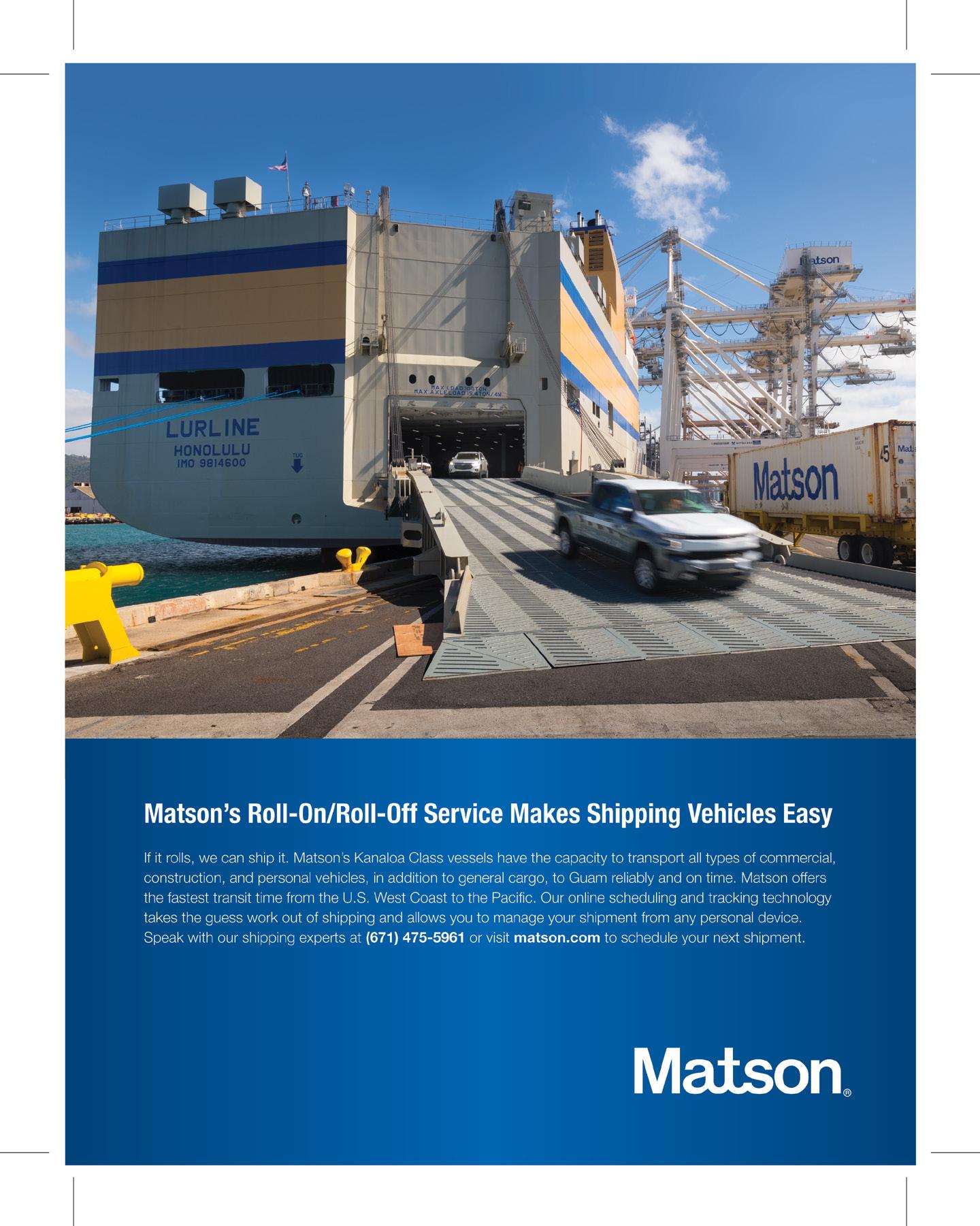A BOND WITH SUBCONTRACTORS

















PRESIDENT
James Martinez
Guam Contractors’ Association
PAST CHAIRMAN
Bill Beery
Tutujan Hill Group
CHAIRMAN
Joe Roberto
East Island Tinting
VICE CHAIRMAN
Matthew Hunter
Dylan Mechanical Construction Services
SECRETARY/TREASURER
Kathleen David
Pacific Rim Constructors
CONTRACTOR DIRECTORS:
Don McCann
Black Construction Corporation
William Best
SmithBridge Guam
AJ Perez
Hawaiian Rock Products
Brian Holm
Hensel Phelps
Soraya Vongjalorn
Vertex Guam
ASSOCIATE DIRECTORS:
Mark Cruz
Mid Pac Far East
Jose Garcia
First Hawaiian Bank
Camilo Lorenzo
Matson Navigation
Geri Leon Guerrero
Adztech Advertising and PR
JOIN ONE OF OUR MANY COMMITTEES!
Guam Contractor’s Association (GCA) in conjunction with Adztech and Public Relations, Inc. publishes the Construction News Bulletin (CNB) monthly. Reproduction of materials appearing in this publication is strictly forbidden without written permission by GCA.
While we always strive for accuracy, we will from time to time overlook mistakes. In order to help us improve the quality and accuracy of this publication, we ask that you take the time to look at the information provided and notify GCA or Adztech of any corrections as needed. Opinions and editorial content of this publication may not necessarily be those of the publisher, production team, staff, GCA members, GCA Board of Directors and advertisers.
For more information about advertising in the GCA Construction News Bulletin contact the advertising department at (671) 477-1239/2239 or email at adztech@teleguam.net.
Distributed to GCA members or can be obtained by stopping by the Guam Contractors’ Association office located at 506 Mariner Ave., Barrigada, Guam 96913
To find out more about how you can become a GCA member contact Guam Contractors’ Association at Tel: (671) 647-4840/41 Fax: (671) 647-4866 or Email: gca@teleguam.net. www.guamcontractors.org
Postmaster. Send address changes to Guam Contractors’ Association, located at 506 Mariner Ave., Barrigada, Guam 96913
PUBLISHER: James Martinez
PRODUCTION TEAM
LEAD:
Geri Leon Guerrero
AD SALES: Alyssa Roces
PRODUCTION:
Alyssa Roces
Jason Davis
Christopher “Taco” Rowland
PHOTOGRAPHY:
Alyssa Roces
EDITOR:
Adztech
CONTRIBUTING WRITERS:
Joanna Rupley Sablan
Rodney “RJ” Ricarte
Adam Baron
GCA STAFF:
Desiree Lizama
Elaine Gogue
Francine Taitague
Trevor Cruz
COVER:
A good bond between a Prime and a Subcontractor can never be understated. In todays climate being able to rely on each other is paramount.




































“Having our home windows tinted by East Island Tinting was an e xcellent decision. Our power bill dropped enough to pay for the work in less than a year. Even better, our home is much cooler and more comfor table when we walk in after a long, hard day.”

 Kelly and Maria Fitzpatrick Home Owner
Kelly and Maria Fitzpatrick Home Owner



1

Starting an apprenticeship program within your company can be a valuable investment in developing a skilled workforce.
But how do you get started? What do you do first? Here are five steps your company — with the help of the Guam Contractors Association — should consider when creating an apprenticeship program.
Assess Your Needs. Set Goals.
Identify the specific skills and competencies your company needs now and in the future. Determine the areas where apprenticeships can make the most significant impact. Set clear goals and objectives and ask yourself what you aim to achieve with this program. Clearly define goals to measure progress.

Develop an apprenticeship program that outlines the duration, curriculum, and progress of the participants. This should include both on-the-job training and classroom-based learning. Define the roles and responsibilities of mentors, supervisors, and trainers who will guide and support apprentices throughout the program.
Establish partnerships with educational institutions (GCA Trades Academy) and industry associations (Guam Contractors Association), to ensure that your apprenticeship program aligns with industry standards, and offers nationally recognized certifications. The Guam Contractors Association keeps track of hours worked and the education progress of the apprentice. We can guide your company through the process. What have you got to lose?
4 Recruit. Recruit. Recruit.
Develop a recruitment process for selecting apprentices. Consider both internal employees and external candidates. Use criteria such as aptitude tests, interviews, job fairs, recommendations from current employees, and past performance to assess candidates' suitability for the program.
Provide ongoing support and mentorship to apprentices throughout their journey. Regularly assess their progress and offer constructive feedback. Continuously evaluate the apprenticeship program's effectiveness and make necessary adjustments to improve its outcomes. Encourage open communication between apprentices, mentors, and management to promptly address any issues or concerns.
Ensure your apprenticeship program complies with relevant labor laws and regulations. Be prepared to invest time, resources, and effort into the program, as it can take time to yield the desired results. A well-structured apprenticeship program can contribute significantly to employee development, skills enhancement, and overall organizational success.
Join the growing community of companies that have, or are in the process of, creating an apprenticeship program to enhance the skills of its workforce.
Interested in learning more?

Maintaining a high level of quality and safety is important to the TakeCare GCA Employee Health Plan. Just as a solid foundation is essential in construction, a strong healthcare foundation ensures the well-being of individuals and communities.
TakeCare encourages its members to live the Balanced Lifestyle — being active, eating right, relaxing and unwinding and staying socially connected — as a way to build a healthy foundation. We also believe in the value of accreditation to make sure our processes are at the highest standards possible.
TakeCare Insurance Company, Inc. has once again earned national accreditation from the Accreditation Association for Ambulatory Health Care (AAAHC). This achievement underscores TakeCare’s commitment to excellence and elevates the value of your GCA Employee Health Plan.
Established in 1979, AAAHC stands as a premier private, non-profit organization dedicated to enhancing patient safety, quality care, and value in ambulatory health settings. With more than 6,000 accredited organizations spanning various healthcare practices including ambulatory surgery centers to medical group practices, AAAHC's rigorous peer-based accreditation processes, education, and research drive industry-wide improvement.
Accreditation is not just a badge of honor; it signifies adherence to stringent operational and program standards.
AAAHC's health plan accreditation program has gained recognition from state and federal regulators, as well as healthcare professionals. Auditors from AAAHC meticulously assess TakeCare's critical operations in areas such as quality improvement and risk management, administration, member rights, wellness and health promotion, utilization management and care coordination, network adequacy and provider credentialing. For members of TakeCare’s GCA Employee Health Plan, this accreditation ensures that you're part of a system that places your well-being at the forefront.
The recent renewal of TakeCare's accreditation speaks volumes about our commitment to continuous enhancement and growth. TakeCare has long been a pioneer in the region, receiving its initial three-year accreditation in 2016 and a renewal in 2019. This 2022 accreditation renewal extends our commitment through 2025, emphasizing our dedication to maintaining the highest standards in your health plan.
Just as a well-constructed building endures for generations, a well-structured health plan ensures the longevity of individual health and collective well-being. TakeCare's AAAHC accreditation is a testament to our pursuit of excellence, setting a benchmark for others in the industry to follow. As members of TakeCare’s GCA Employee Health Plan linked to accredited providers, you can rest assured that your health and safety are in capable hands.
In this collaborative effort between the GCA and TakeCare to improve health care in Guam’s construction industry, we recognize our shared values of quality, safety, growth and continual improvement. TakeCare's AAAHC accreditation is an example of our commitment to building a healthier future.
Rodney “RJ” Ricarte is the TakeCare account executive for GCA. He can be contacted at (671) 487-7121 or rodney.ricarte@takecareasia.com.

TakeCare Insurance Company, Inc. has achieved another three year health plan accreditation by the Accreditation Association for Ambulatory Health Care (AAAHC). Through AAAHC accreditation, health plans demonstrate their commitment to providing high quality services and patient care for their members
Health plans seeking accreditation by AAAHC undergo an extensive self-assessment and a rigorous on-site survey by AAAHC expert surveyors – physicians, nurses, and administrators who are actively involved in health care organizations. Below are the characteristics that are indicative of an accreditable health plan
Customer Service (671) 647.3526

The construction industry itself is always filled with its fair share of excitement. With today’s record setting military spending, the construction economy in Guam is booming and there is ample opportunity for growth - which comes with its own risks and challenges. The rewards are great to those that can survive to the end of the boom. The companies that can address their obstacles and stumbling blocks along the way are often the ones left standing tall and proud.
What are the challenges that our prime contractors face today? To name a few of the obvious: shortages of critical material items, labor pool management…and limited availability of experienced subcontractors. Many of our prime contractors rely on experienced subcontractors to fill in gaps or play critical niche roles, however, quality subs are now in high demand and in short supply. A prime would be very lucky to have a loyal pool of quality, dependable low risk subs that are happy to stay low profile and low risk. But opportunity calls…and this is the time when a small sub can step out of the shadows and shine, make a reputation for themselves in the industry, and be on the path to becoming a bigger player if they can expand successfully. Many will succeed, but a few of them will try, falter, and eventually fail, leaving collateral damage and financial loss to the primes they are working for.
What causes a sub to fail? There are a variety of factors that – on their own or combinedaffect a sub such as: an overwhelming amount of work, insufficient labor, stretched financial resources, failure to recruit & retain good talent, slow expansion of back-office needs, and lack of other professional needs. The contractors that can balance the growth of their resources well will reach greater levels of success than those that don’t.
With reliance on subs being greater than ever, how can a prime determine which subs would make the best partners? You have several
options to help guard your company against subcontractor failures. One of the options is to obtain subcontractor performance and payment bonds. The benefit to having a bond goes beyond the obvious ability to claim to the subcontractor’s surety in the event of default and/or termination of the subcontractor. When a bond is requested by a subcontractor (any contractor, for that matter), the surety digs deep to thoroughly vet the company’s abilities to perform the work, ability to honor its obligations and seeks to detect in advance if any elevated risk of failure is present when underwriting each bond. If the company comes up short with any of an array of underwriting criteria, the surety may inform the company it will not be able to support the bonds currently requested. There can be a multitude of reasons why a surety might say ‘no’ to a bond request.
Personally on this subject, before 2023, the last time I was called by a prime to help a struggling subcontractor facing termination was about 20 years ago. This year alone, I have been in two of these situations. Thankfully, both seem to be progressing back on track, but it does prove the growing pains subcontractors are facing in this rapidly expanding construction industry we are in.
Thus, when a subcontractor provides a subcontract performance and payment bond, the prime not only holds the financial protection it seeks against possible subcontractor failure, but it also can recognize the implication of having those bonds in hand: that the surety has completed an exhaustive investigation as to the financials, job performances, capital, equipment, experience, capability, engineering demands, managerial demands, labor force, tax issues - and a multitude of other criteria – and has deemed all these to be of a sufficient level with no foreseeable reasons why the sub wouldn’t be able to perform the work as prescribed in the subcontract…and will then authorize the issuance of the subcontractor performance and payment bonds. It’s this prequalification
process that is the lesser-known intrinsic value of subcontract bonds that can be so valuable. This process helps weed out subcontractors that, unbeknownst to the prime, may be sorely unready to embark on a particular project.

Keep in mind as well, that the subcontractor’s surety will very likely have full corporate and personal indemnity, perhaps even collateral as security, to help best assure that the subcontractor will complete its bonded obligations. This means the subcontractor, and its individual shareholders personally, have guaranteed the surety full reimbursement in the event the surety steps in and incurs expenses to rectify the subcontractor’s problematic situation. This indemnity weighs very heavily on a subcontractor’s decisions.
Many subcontractors work for a several different prime contractors concurrently. Some of the primes may have required bonds, some may not. 99% of the time, the sub will complete all projects on hand, bonded and unbonded, with no issues. However, on occasion, the sub may find itself in a dire situation where they must choose where to
deploy their limited resources. Self-preservation (and indemnification to the surety) would lead them to focus those precious resources on the bonded subcontracts over the unbonded projects.
As the saying goes, everything goes well…until it doesn’t. Most of the time the subcontractor will complete their obligations, but there are the times when things go wrong. And, when they go wrong, they can go VERY wrong. This is why we believe the value of sub bonds in today’s construction environment is so high. It is better to be prepared, and protected, with subcontractor performance and payment bonds.
If you are a prime and would like to explore the ability of your subs to establish a bond program, please have them reach out to our bond department here at Cassidy’s. We represent six active surety companies who can support many of the subcontractors on the spectrum, from the smallest to the largest. We are happy to provide our guidance and expertise along the way.


August 16th, 2023 Hilton Guam Resort



HOLE-IN-ONE SPONSOR
First Hawaiian Bank
HOLE SPONSORS
AB Risk
American Pres. Lines
Ambros
AXS
Bank of Guam
BME & Sons
CRW
First Hawaiian Bank
Guahan Waste
Infratech
Isla Coating
Matson Navigation
Oceania Elevator
Perfeturo
Ready Ice
Take Care
Isla Coatings & Roo ng Supply Island Equipment Company
CONTRIBUTING SPONSORS

Ready Ice
MATSON
Triple J Five Star

Payless
Pepsi
Guam Bakery
Hawthorne Paci c
Ambros
Take Care
Special Olympics Guam
G4S Security Systems (Guam), Inc. CEVA Logistics, Guam
CLOSEST TO THE PIN
Docomo Paci c
LONGEST DRIVE
Johnstone Supply

CLOSEST TO THE PIN
Docomo Paci c

$500 DONATION
Hanson Permanente
SHIRT SPONSOR TakeCare
HATS SPONSOR Vertex
HOLE SIGN SPONSOR Island Color & Copy
EXCLUSIVE ALCOHOL BEVERAGE Ambros
Sponsored by:




On Aug. 8, the U.S. Department of Labor issued its final rule, Updating Davis-Bacon and Related Acts, making drastic revisions to existing regulations concerning government-determined prevailing wage rates that must be paid to construction workers on federal and federally assisted construction projects funded by taxpayers.
The new rule was hailed by Vice President Kamala Harris and Acting DOL Secretary Julie Su in a speech to union construction workers and leaders in Philadelphia, and the White House released a fact sheet on the new rule.
ABC issued a statement opposing the new rule, which was picked up by more than 700 publications, stating,
“This is yet another Biden administration handout to organized labor on the backs of taxpayers, small businesses and the free market,” said ABC Vice President of Regulatory, Labor, and State Affairs Ben Brubeck.
“Unfortunately, the DOL’s final rule disregards the feedback of ABC contractors, construction industry stakeholders and thousands of small businesses urging the withdrawal of this unnecessary, costly and burdensome regulation. Instead, the DOL is moving forward with dramatic changes to prevailing wage regulations, reversing much-needed reforms that were established nearly 40 years ago, and unlawfully increasing the regulatory burden on small
businesses, new industries and public works projects.”
ABC also gave interviews to top-tier national media, generating sympathetic coverage in The Washington Examiner, Yahoo! News and dozens of local television stations. Overall, coverage was featured on MSN, The Washington Post, U.S. News and World Report and more, reaching millions of readers and viewers.
In May 2022, ABC submitted nearly 70 pages of comments on the DOL’s ABC-opposed March 2022 proposed rule, and its more than 50 significant changes, urging the DOL to withdraw the proposal. ABC’s comments detailed how the proposed rule violated existing law and would fail to fix the DOL’s unscientific wage determination process, rescind pro-taxpayer reforms made by the Reagan administration and increase regulatory burdens on small businesses, new industries and more public works projects.
ABC staff is still conducting thorough analysis on the more than 800-page final rule, but its initial review and this DOL chart confirm several key changes to existing regulations:
• Changing the definition of “prevailing wage” to a wage paid to at least 30% of workers surveyed in a locality, a reduction from the 50% threshold established during Reagan administration reforms enacted nearly 40 years ago
• Allowing the DOL to adopt state or
local prevailing wage rates as DBA wage rates
• Making DBA requirements effective by “operation of law,” meaning even if a federal agency fails to include DBA clauses in a contract, contractors are still required to pay prevailing wages
• Adding new anti-retaliation provisions to DBA contracts
However, the DOL did modify a number of provisions of the proposed rule, in some cases directly referencing ABC’s comments in its decision to mitigate some of the rule’s harmful provisions, including:
• The proposed rule intended to expand DBA coverage to any off-site facility where a “significant portion of the building or work is constructed,” but the final rule recognized the unfeasible scope of this requirement and instead only covers off-site construction at sites specifically established or dedicated exclusively to a DBA project
• The proposed rule would have required compensation of delivery drivers at DBA wage rates for almost all on-site delivery work, even for only a few minutes, but the final rule instead exempts drivers spending minimal time on site from DBA
The final rule is schedule for publication in the Federal Register on Aug. 23, and will take effect 60 days later.
ABC is evaluating compliance, advocacy and litigation strategies.
ABC is offering a members-only webinar on Aug. 21 at 3 p.m. ET and will continue to provide additional resources to assist contractors in complying with these new regulations at abc.org/davisbacon.
To learn more about the final rule, see ABC general counsel Littler Mendelson’s analysis.
The new rule is also opposed by key congressional leaders, including Senate Health, Education, Labor and Pensions Ranking Member Bill Cassidy, R-La., who blasted the Biden administration’s new rule, stating, “This is the last thing our country needs as families continue to live with the painful effects of the Biden administration’s inflation agenda.”
House Education and the Workforce Committee Chairwoman Virginia Foxx, R-N.C., also released a statement calling the new rule “wrong” and stating that it “will also drastically increase the costs of federal construction projects, leading to fewer
completed infrastructure projects and a greater burden on taxpayers.”
Cassidy and Foxx have also questioned Su’s indefinite appointment without Senate confirmation in potential violation of the constitutional provision of advice and consent that could open any DOL action under Su’s leadership to legal challenges.
The 1931 Davis-Bacon Act and related regulations require contractors and subcontractors that perform work on federal and federally funded construction projects to pay a government-determined prevailing wage and benefit rate on an hourly basis to on-site construction workers. According to the DOL rulemaking, the Davis-Bacon Act and 71 active Related Acts collectively apply to an estimated $217 billion in federal and federally assisted construction spending per year—about 63% of all government construction put in place—and provide government-determined wage rates for an estimated 1.2 million U.S.
construction workers.
The Congressional Budget Office estimates that repealing the 1930s-era Davis-Bacon Act would save the federal government $24.3 billion in spending between 2023 and 2032.
A May 2022 study found that the Davis-Bacon Act costs taxpayers an extra $21 billion a year, increases the price tag of construction projects by at least 7.2% and inflates construction workforce wages by 20.2%, compared to local market averages, if the DOL calculated prevailing wages using modern and scientific methodology via the U.S. Bureau of Labor Statistics.
The Federal Acquisition Regulatory Council plans to issue a proposed rule on Aug. 3, 2023, that would establish new requirements for “sustainable procurement” in federal contracting. The proposal complies with Executive Order 14057, Catalyzing Clean Energy Industries and Jobs Through Federal Sustainability, signed by President Joe Biden on Dec. 8, 2021.
The proposed rule restructures and updates numerous existing FAR
environmental and sustainability requirements, consolidating these requirements under FAR Part 23.
Additionally, the proposal increases sustainable acquisition requirements. Under existing regulations, agencies must ensure that 95% of new contracts for products and services utilize sustainable materials. The proposed rule replaces this provision with a requirement that agencies purchase sustainable products and services “to the maxi-
mum extent practicable.” Exceptions are possible where agencies cannot acquire a sustainable product or service on a reasonable schedule, meet performance requirements or obtain a reasonable price.
Comments on the proposed rule will be due 60 days from the date of publication.
On July 26, ABC Senior Director of Legislative Affairs Peter Comstock participated in a roundtable hosted by the U.S. House of Representatives’ Education and the Workforce Committee Chairwoman Virginia Foxx, R-N.C. The roundtable focused on the reauthorization of the Workforce Innovation and Opportunity Act and policies to better connect job creators and small businesses with job seekers.
The WIOA reauthorization provides the opportunity to upskill, educate and grow a productive workforce for construction that will assist the construction industry’s ability to complete projects in an effective and efficient timeframe. ABC highlighted the new challenges and workforce shortages that have left many contractors throughout the country in desperate need of qualified, skilled craft professionals. ABC believes that any

reauthorization of WIOA must consider best practices from industry to better expand workforce development opportunities for all of America’s workers.
The roundtable was attended by committee members Reps. Rick Allen, R-Ga., Bob Good, R-Va., Glenn Grothman, R-Wisc., Kevin Kiley, R-Calif., Lisa McClain, R-Mich., Burgess Owens, R-Utah, and Tim Walberg, R-Mich.

























DIAMOND SPONSORS
PLATINUM SPONSORS


GOLD SPONSORS
SILVER SPONSORS
BRONZE SPONSORS

Isla Coatings and Roo ng Supply • Island Equipment Company G4S Security Systems (Guam), Inc. • CEVA Logistics, Guam

